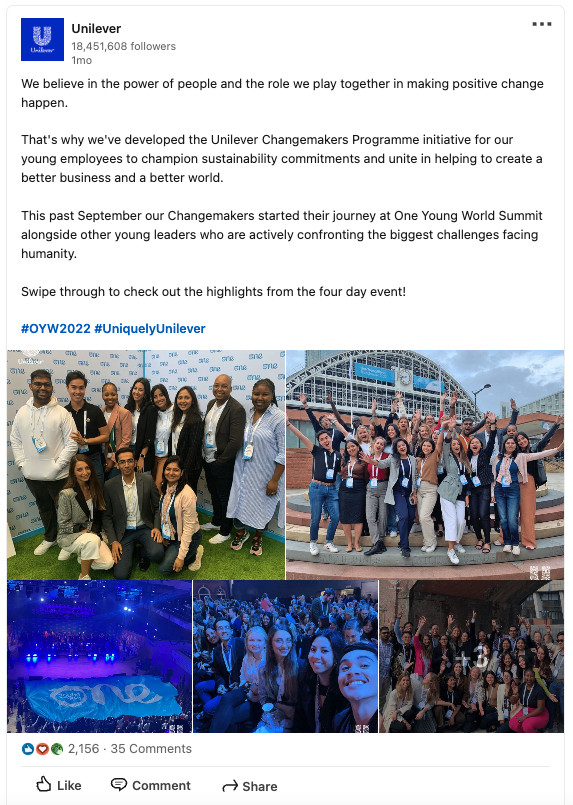LinkedIn is the largest social networking channel designed for professionals to interact with each other across companies and industries. It offers a wide variety of content from work opportunities, career advice, business inspiration and more.
As a company, it’s probably your best platform for building a reputation and growing your business-to-business (B2B) social audience — both of which are integral to effective social media marketing.
Yet, it can be overwhelming trying to determine what type of content best works on this professional platform. LinkedIn can be a difficult beast to tame compared to other channels, such as Twitter or Instagram. Beyond creating a company page, it can feel like your content may be lost in the ether of the LinkedIn feed if you don’t read the room right.
That’s why we’ve broken down the 5 best types of content to post on LinkedIn that’ll help you stand out and start creating a name for yourself online:
What You Need To Know Before You Post on LinkedIn
LinkedIn’s audience of more than 800 million people is anything but captive — 40% access the platform on a daily basis and spend an average of 56 minutes on the platform each week, or about 8 minutes per workday.
That said, users usually go there with 1 of 2 clear purposes:
- Discover relevant content that helps their career or somehow serves their own efficacy within a given industry. No one’s impervious to distraction, but we don’t expect to be bombarded with vacation photos and funny cat videos on a professional networking site. Our attention is inherently more trained on business matters.
- Create, curate and share content with the intent of making ourselves more visible to prospective employers, business partners, etc.
That second item is particularly compelling. LinkedIn, more than any of the other social media platforms, was built for content marketing. It’s where people go to become influencers, build authority and engage with other professionals.
LinkedIn, more than any of the other social media platforms, was built for content marketing.
But that doesn’t make content marketing any easier on the platform. Setting aside the fact that LinkedIn users are less prolific than other social networking sites, let’s keep in mind that more than 82% of marketers choose LinkedIn as their preferred content distribution platform. Competition is abundant and time with the audience is scarce.
So Why Is LinkedIn So Worth the Time and Effort?
Here are just a few reasons:
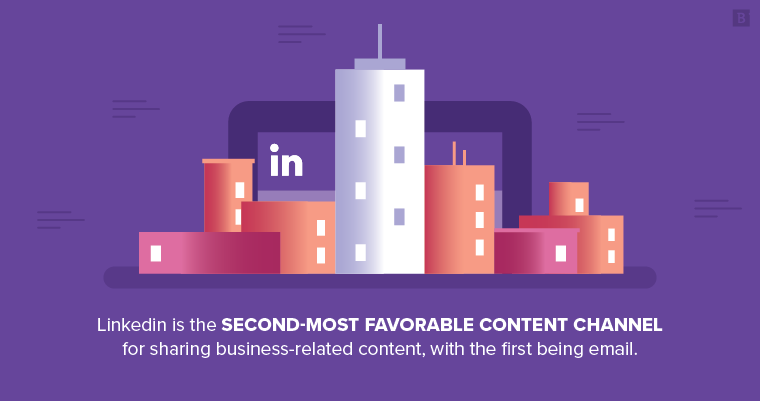
- When you have a LinkedIn profile, there’s a good chance that the right people will see it. 180 million of its users are senior-level executives, while another 63 million are in decision-making positions. The platform is replete with the types of people who have the ability to authorize spending on your products and services.
- It works. More than 50% of all social traffic to B2B sites comes from LinkedIn.
- It can build your brand. Sharing and posting your own LinkedIn content to your personal profile can show your followers your interests, career aspirations and potential for future endeavors.
- Professionals are consumers, too. B2C brands can tap into a career-focused network of earners by cleverly positioning their products into the professional’s story. Case in point, L’Oréal using the platform to sell beauty and personal care products:
Still, successfully using LinkedIn as part of your marketing strategy requires a strong understanding of your target audience and what makes them tick. You also need to know the types of content they’ll find useful enough to click on in a news feed that may be populated with posts from thousands of connections.
For starters, that means actually knowing what types of content to share and post on the social platform.
Subscribe to
The Content Marketer
Get weekly insights, advice and opinions about all things digital marketing.
Thank you for subscribing to The Content Marketer!
Not Sure What to Post on LinkedIn? Consider These 5 Content Types:
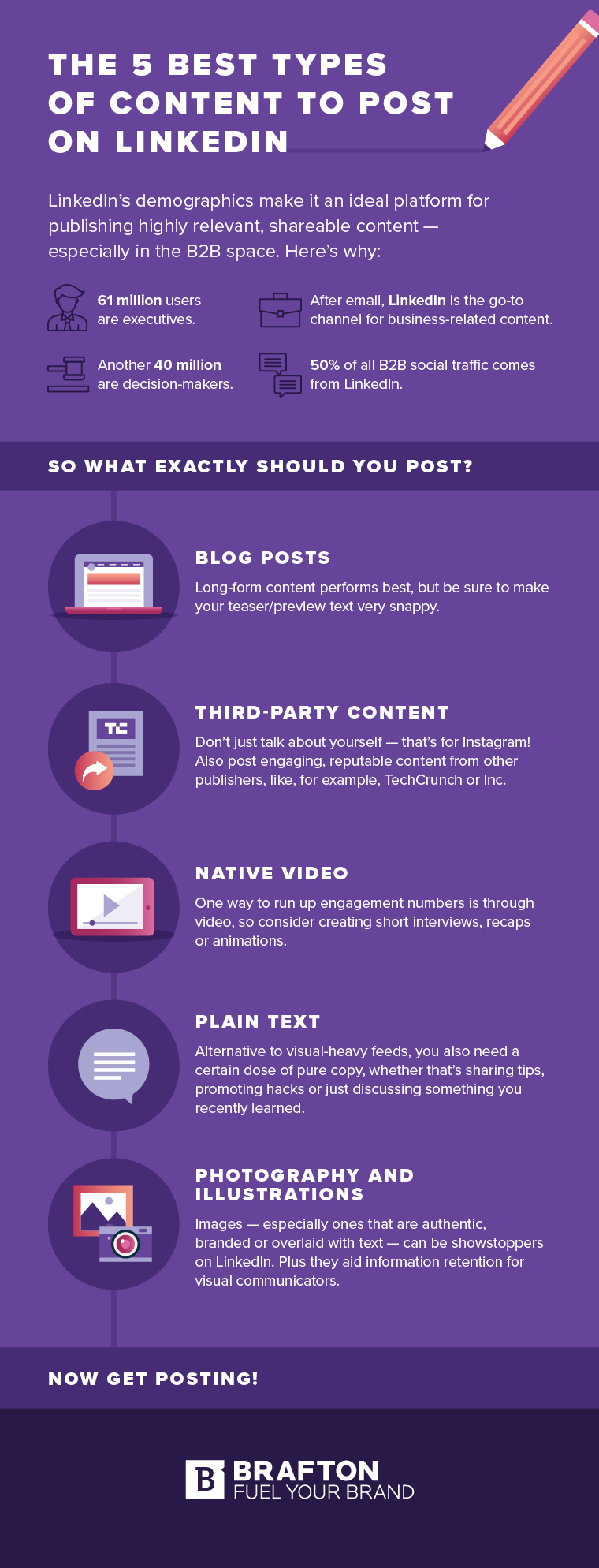
1. Blog Posts
There are a few ways to share a blog post on LinkedIn. One is to use the native publishing platform to create content directly through the social network. Just click “Write an article” on the top of your feed.
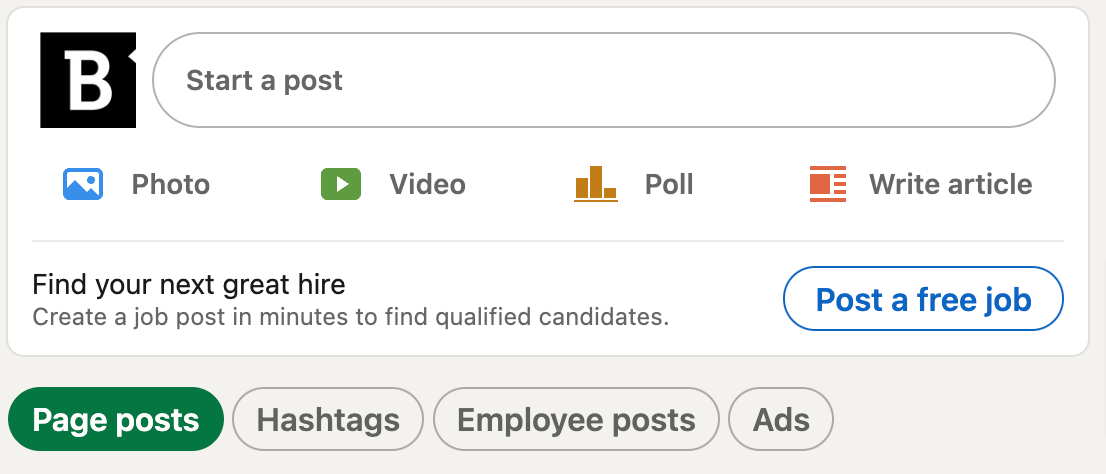
The other is to share the link to an article on your company’s website. We might call this a “status update.”
A third option is to republish a blog post that has appeared on your company’s blog directly to LinkedIn’s publishing platform. This is called syndication. Note that LinkedIn won’t you let publish content directly from your organization’s page. Rather, someone from your company would need to publish it on their profile on behalf of your organization.
Best Practices:
- When distributing/promoting your company’s blog content on LinkedIn, make sure you include some sort of teaser text, or perhaps even a particularly compelling one- to two-paragraph excerpt, and not simply a hyperlink and feature image.
- If you syndicate to LinkedIn, publish on your blog first. Unlike Medium and other syndication sites, LinkedIn doesn’t enable the inclusion of the “rel=canonical tag” that tells Google which piece is the original. You won’t negatively impact SEO as long as the post is originally published on your blog and you link to that post in the reposted version.
- Long-form quality content (~2,000 words) performs better than shorter articles when posted through LinkedIn’s article-publishing platform.
- The maximum length for a LinkedIn post (on the news feed) is 1,300 characters, which equates to 200-250 words. It’s always better to make a compelling point in fewer words if possible since most users are scanning through their feeds.
Long form content (~2,000 words) performs better than shorter articles when posted through LinkedIn’s article-publishing platform.
2. Third-Party Content
LinkedIn is all about starting conversations and building relationships, and sometimes that means talking about something other than your own brand. It may sound counter-intuitive, and it’s certainly true that clicking on a link to say, a Forbes article, takes the user away from your brand and to another site.
But you want your target audience to associate you with valuable information. Because if they do, they’ll be that much more likely to click on your original content. Furthermore, each time they like something you post, that activity appears on connections’ news feeds.
You want your target audience to associate you with valuable information.
You want your target audience to associate you with valuable information.
Best Practices
- Don’t just post links with comments like “interesting!” or “ great read.” Find a way to add an idea to the conversation, or tie the concept back to your brand — especially if it supports your prior thought leadership.
- Avoid posting anything overly controversial, contentious or overtly political.
- LinkedIn has a content ideas feature to help companies identify topics that are popular with their target audience. This feature can also be useful for topic ideation.
- Use hashtags to categorize third-party content for your audience. This is also a good tip for original content.
- Shorten long URLs with bitly.
3. Native Video
Not to be confused with the video ads that LinkedIn is aggressively marketing, native video is any unsponsored video content that you share with your network, meaning you haven’t paid for its placement in a news feed.
Some sources have cautioned users away from video. For instance, one study correlated zero multimedia embeds in posts with higher average LinkedIn views.
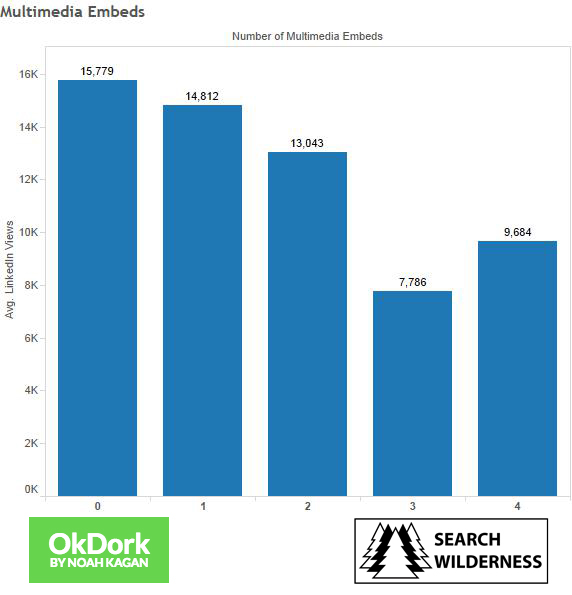
However, this data is correlative and doesn’t necessarily indict multimedia. When viewed as a binary (no multimedia vs. multimedia inclusion), there are indeed significantly more aggregate views favoring the latter. Furthermore, this goes against what many experts have been saying about video content for several years. A separate study found that 51% of video marketers leverage LinkedIn, and of those, 84% have been successful in those efforts.
Most importantly, though, video’s success is dependent on how you use it. The fact is, few people will actively click on, say, a 5-minute video, as they scroll through their LinkedIn feed. For context, presuming an average length of 3 minutes, 48 seconds, a user will typically watch 10 seconds of the content, which is 4% of the video.
What this essentially tells us is that shorter is better for video. LinkedIn has indicated as much, noting that the most successful video ads are 15 seconds long or less. This doesn’t mean you should abandon videos in the 3-minute range — only that you should consider using a shorter cut for LinkedIn to promote the more extended version.
Consider using a shorter video cut for LinkedIn to promote the longer version.
Some ideas for content that are well-suited to this format include:
- A tips and tricks video series where you provide one quick industry best practice on the first day of each week.
- Teasers for a longer-form case study, or a 30-second roundup of the biggest industry news for that week.
- A quick event recap.
- A simple animation introducing a new partnership or product feature.
- One particularly compelling quote or answer from a longer video interview, as done by Amazon in this post:
Best Practices
- Keep it short if you embed it in your news feed.
- Use subtitles (especially when posting videos that are longer than say, 30 seconds). About 97% of videos are viewed without sound while scrolling through a feed.
- Provide a call to action for your short videos. For instance, your video blog summarizing a weekly roundup might tell the audience where they can read the full version in the final seconds of the cut.
- Add some textual content to introduce a video. This makes it much easier to create shorter videos.
So long as a video is short, sweet and to the point — as well as being attractive, informative and entertaining — it can be one of the more valuable assets to share on your LinkedIn profile. Using a video compressor software can help you make your video load faster and more approachable.
4. Text Only
LinkedIn users often just scan their feed between doing whatever it was they went there for in the first place. While visual content is great at giving the eye something to latch onto, it can also be an encumbrance if the copy is the most engaging aspect of the content.
Sometimes, tips and quick text-only nuggets of content are the best way to get someone’s attention. Here’s an example:
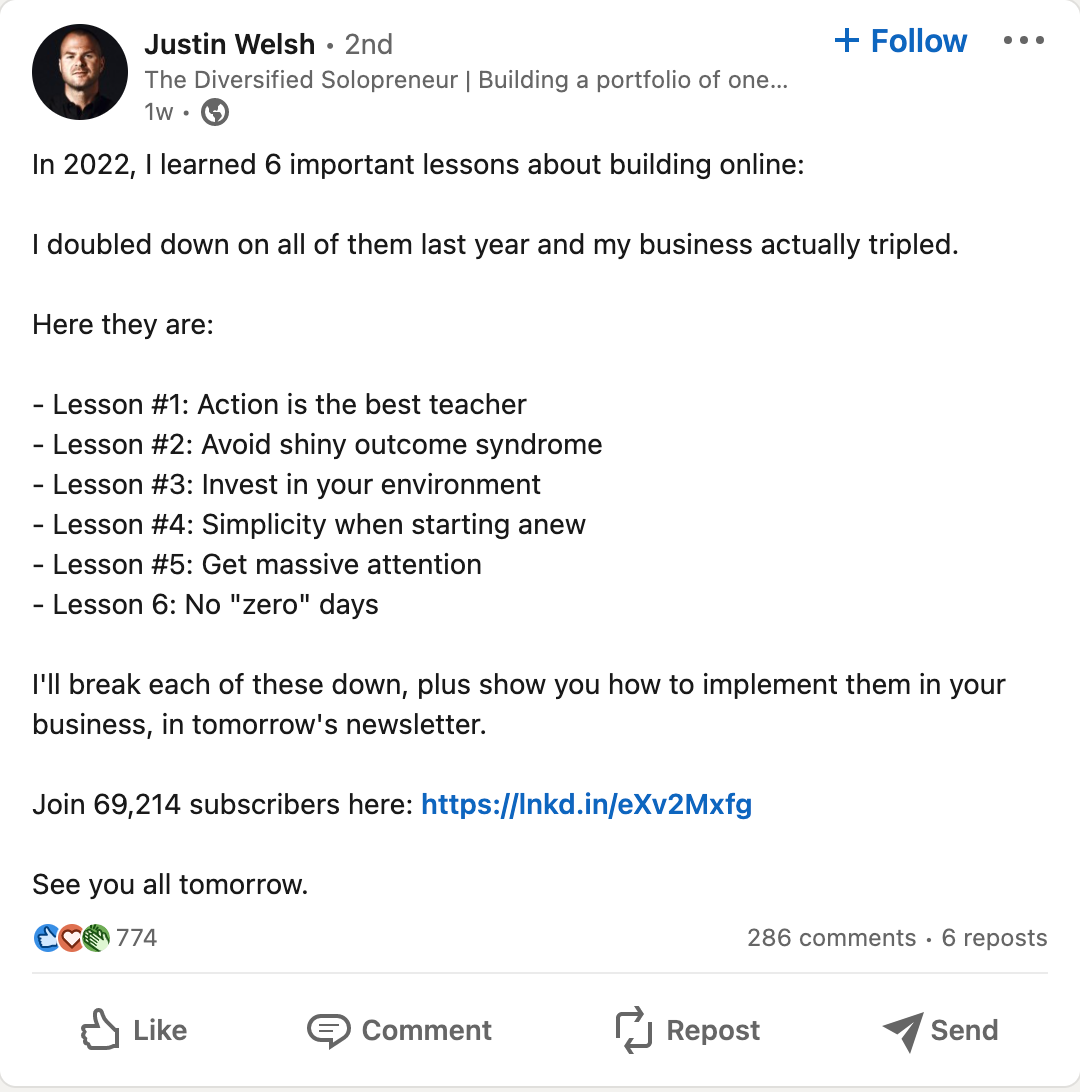
The idea of a simple all-text list may seem odd, but it can serve several core functions. For one, it can help break up an otherwise image-heavy feed of content.
They can help improve engagement via hyperlinks, and there’s something vintage, authentic, accessible, and, perhaps, even intimate about a simple message that appears to provide interesting and useful information without shiny, branded images. If you create all-text posts that are genuine and touch on subjects your LinkedIn audience cares about, people will engage with you and possibly even commiserate.
There’s something vintage, authentic, accessible and perhaps even intimate about a simple message that appears to provide interesting and useful information without any links or shiny, branded images.
Some examples of potential all-text posts might include an interesting excerpt from a book, an inspirational quote, some quick tips, a riddle, a survey or a short step-by-step guide to a process.
Best Practices
- Use hashtags. They can help improve engagement by making it easier to find relevant content. For instance, typing #WritingTips into the LinkedIn search bar will display any content featuring that hashtag on your news feed. (This applies to most if not all of the other content types on this list).
- Keep sentences short to convey meaning quickly.
- Use a conversational tone that your audience will find accessible and sincere.
5. Photos and Graphics
Text-only posts have their place on LinkedIn, but a cursory glance at your newsfeed is enough to remind you that imagery absolutely dominates this media platform, which makes sense. The mind excels at processing imagery, especially when that imagery does a really good job of providing information or making a point at a glance.
Photos and graphics can be used to complement a point you’ve made in a short post, or as a standalone element that can convey information on its own. Take this example of a chart from the Content Marketing Institute:
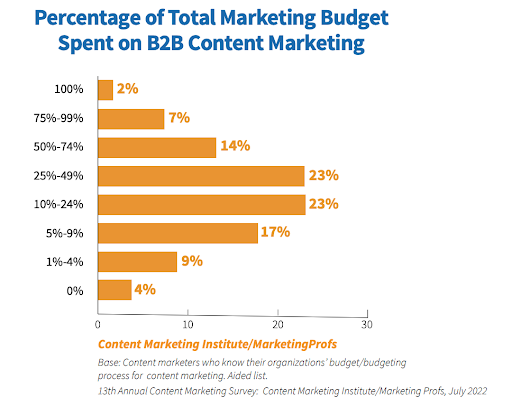
It not only imparts interesting information to an audience, but it also gives CMI a chance to talk to promote its annual B2B Content Marketing Benchmarks report.
In that same vein, LinkedIn can be a great way to distribute and promote your infographics. Simply crop the opening section of a larger graphic, and include a link to the full version. This can help drive engagement on LinkedIn while also directing traffic to a website or landing page.
Pictures and graphics can also put a literal face to your organization by highlighting special accomplishments. Here’s an example from Unilever:
This is a great reminder that LinkedIn is about building relationships. Imagery is, in many ways, the face of your brand. It’s often one of the first things that we process upon visiting a website — subconsciously or otherwise — which makes it great for patenting identity and personality.
Best Practices
- Use meaningful imagery. It’s easy to just attach an image to a post as a “visual aid.” But imagery is a communication medium, not a prop. If you can help it, we highly recommend dropping stock imagery altogether.
- Remember, imagery is also about branding. The graphics, blog-accompanying pictures, employee spotlights, event banners and other imagery you post on LinkedIn should always reflect your organization’s branding guidelines. Ideally, a LinkedIn user would recognize your imagery on his or her feed without having to see the name of who posted it.
Imagery is a communication medium, not a prop.
Other Content Types To Consider?
- Live images, videos and/or text updates from events.
- Original research (always a good idea if you have the means).
- The latest episode of your podcast.
- GIFs.
- Screenshots from, or links to, SlideShare decks.
- Links to eBooks, white papers, case studies and other collateral.
- Questionnaires.
Remember: Sharing a variety of content types can attract different audiences, which can also gain you more followers. For example, posting a questionnaire on LinkedIn will not only generate engagement and brand awareness but also ensure you get qualified leads because they completed your assessments with personalized feedback. This proves their interest in your product or service and makes them more approachable. Keep this in mind as you navigate different opportunities for each LinkedIn post.
Final Thoughts: Be Social and Post Consistently
Many brands schedule their content on LinkedIn and expect engagement without giving any back, and that’s a mistake. You can’t build brand relationships on LinkedIn and network effectively by simply talking at people. They’re called social platforms for a reason.
Sharing or liking third-party content you see on your feed from someone in your network is a simple but powerful way to show that your brand is listening. So is responding to comments and occasionally asking questions of your target audience, perhaps by tagging them.
You want to be an authority in your field without being inaccessible. This advice applies to every facet of professional life, including digital marketing.
As for the best times and how often to post?
That’s a tricky one considering there are 24 time zones and your audience may be spread across them.
However, HubSpot pinpoints the ideal post time as anywhere between 3 p.m. and 5 p.m. CDT on Wednesdays. Other high-engagement times are between 8 a.m. and 10 a.m. CDT on Tuesdays, 10 a.m. and 12 p.m. CDT on Wednesdays, and 1 p.m. and 3 p.m. CDT on Thursdays.
Painfully specific? Perhaps. But it makes some sense, seeing as we’re generally less tuned into work and professional matters on Friday, Saturday, Sunday and Monday.
For post frequency, most experts and studies agree that once per work day is a fair average, with the caveat that posting more often won’t do any good if your content isn’t engaging (you can see some examples of compelling LinkedIn content strategies, here).
In general, try to maintain a consistent posting schedule to build steady, ongoing engagement. Pay attention to what your followers enjoy, but make sure to stay true to your brand.
Posting great content on a regular basis might feel difficult at first, but it’s all about developing a habit. Just like exercising and flossing, sticking to it will get you to those desired results.
Editor’s Note: Updated January 2023.


